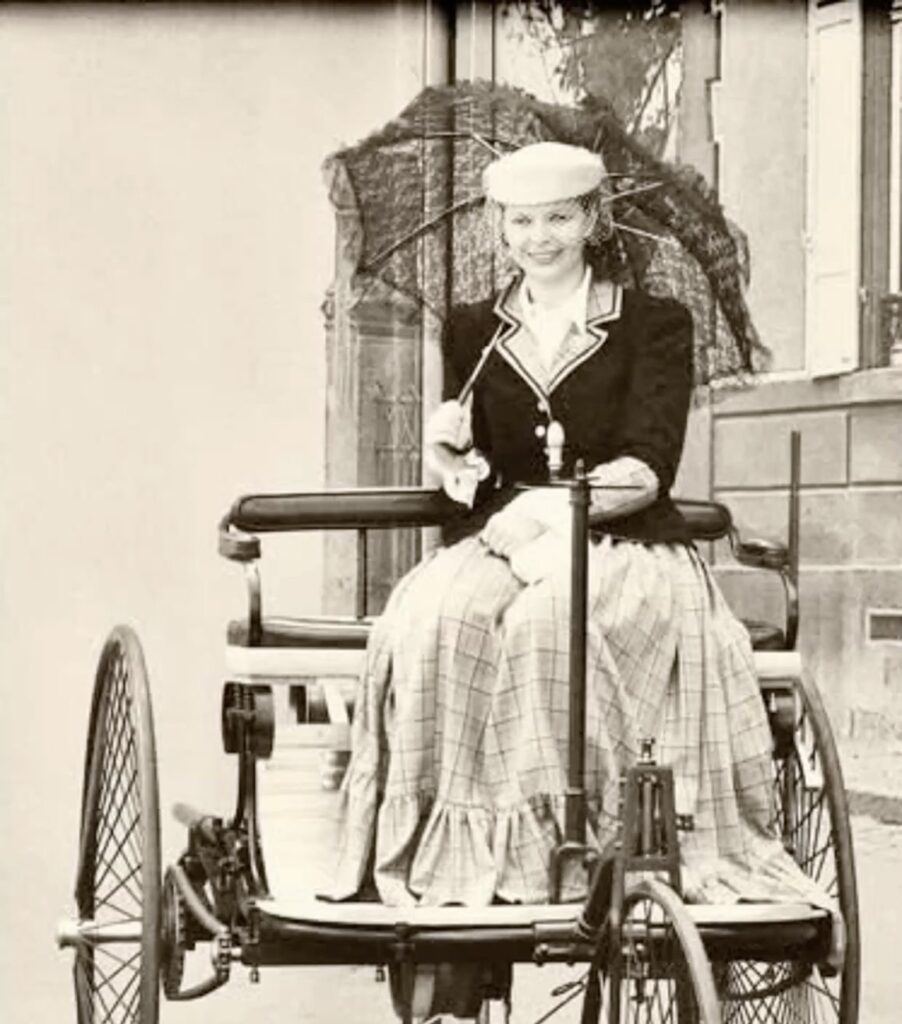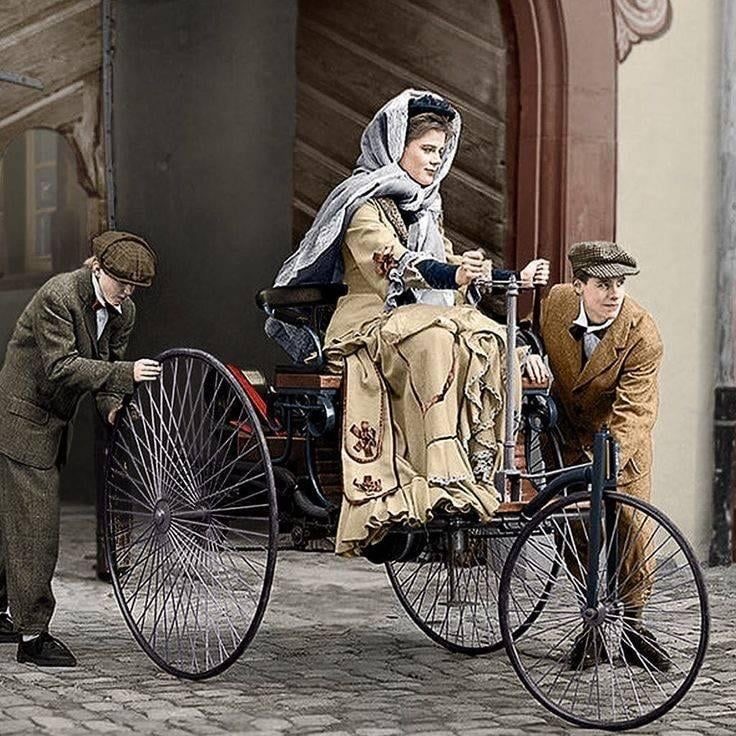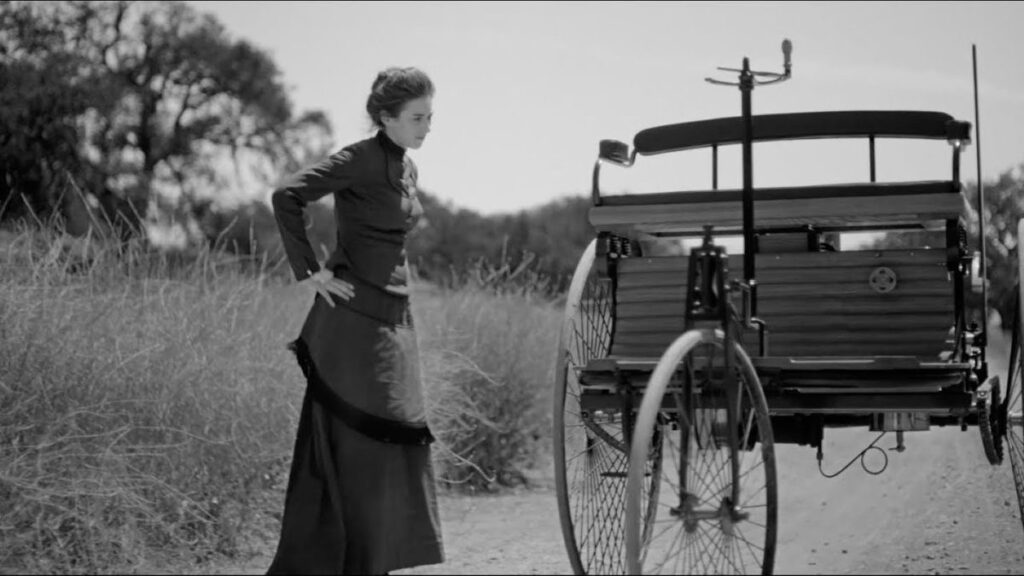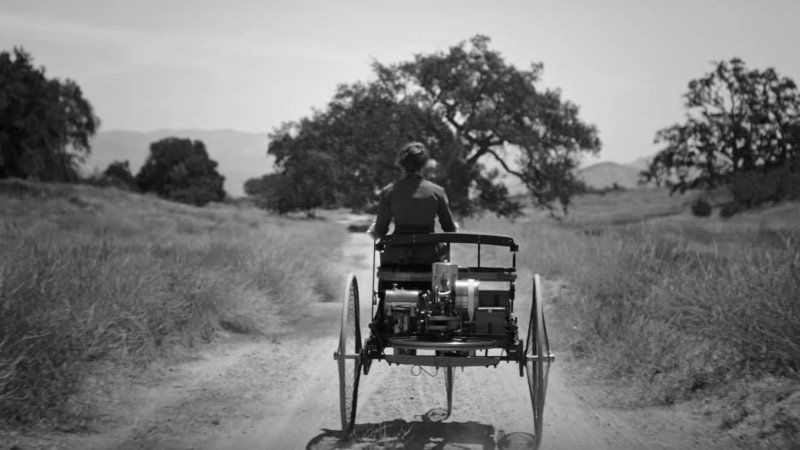They said no respectable woman would be seen behind the wheel of a noisy, smoking contraption.
She said, “Hold my hatpin.”
On a warm August morning in 1888, Bertha Benz did not just take her husband’s strange three-wheeled machine for a spin; she made off with it entirely. No permission, no license, no paved roads, and certainly no plan for what to do when the fuel ran out.
By sunset, she would have invented something the world did not even have a name for yet: the road trip. The interesting part is that she didn’t do it for fun. She did it to rescue an invention that everyone else had already decided was doomed.
A Bold Idea in a Time of Horses
Imagine the year 1888, a time when most people traveled by horse or carriage. The roads were bumpy, muddy, and impassable for motor vehicles. Back then, electric cars were very rare, phones did not exist, and automobiles were considered fanciful machines.
This is the world where Bertha Benz lived. Bertha was the wife of engineer Karl Benz, the engineer who had built a gasoline-powered vehicle called the “Patent-Motorwagen,” which was basically the world’s first real car.

Karl showed his invention off in 1886, but nobody seemed interested in it. The machine clanked noisily, smelled bad, and didn’t look practical. Sales were very poor.
When no one else believed in the invention, Bertha did. She used her own dowry to help her husband pay off his debts and start his business, but the public just shrugged.
Despite the public’s indifference, Karl continued to tinker, but Bertha grew frustrated. ‘Why wait for it to be “perfect?”‘ She wanted the whole world to see how useful this car could be.
Rewriting History
On August 5, 1888, at dawn, Bertha rolled the Motorwagon out. She didn’t drive it, she just pushed it out of the workshop with her two teenage sons, Richard, who was about 13 years old, and Eugen, who was 15 years old.
The trio quietly carried out their operation, hoping Karl wouldn’t wake up. She left him a note saying they were visiting her mother in Pforzheim.
She bought fuel from a small pharmacy in Wiesloch, the very first “fuel station” in history.
Without approval, license, or proper roads, she stole the car and began the world’s first long-distance road trip: about 104 km/65 miles from Mannheim, through Heidelberg, to Pforzheim.

Bertha embarked on a journey full of wild challenges. Back then, there were no gas stations, no signs to point the way, and the roads were designed for horses, not metal wheels.
The Patent-Motorwagen had two gears, wooden brakes, and an evaporative cooling system that needed frequent water refills, and it gave her problems during the journey. Here’s what happened to Bertha:
- Fuel Trouble: She needed ligroin, a solvent that was used like gasoline. She bought it from a small pharmacy in Wiesloch, the very first “fuel station” in history.
- Clogged Fuel Line: The car’s “fuel line” is basically a thin tube that carries the gasoline from the tank to the engine. During Bertha’s trip, dirt or debris blocked this tube, causing the fuel to stop flowing. Without fuel, the engine would stop running. Bertha did not have the right tools, or any fancy ones for that matter, so she pulled out her hairpin and poked it into the tube to clear the blockage, allowing fuel to flow again.
- Ignition Shorted: This means the wires that carry the ignition spark were touching each other in an incorrect manner, preventing electricity from flowing where it was supposed to. Bertha solved the problem by removing her garter and wrapping it around the wire to cover it. That way, the wires will not come into contact with the wrong things and cause problems.
- Chains Broke: There was a big chain that connected the engine to the wheels so that the car could move. If it snapped, the car would be basically useless. Bertha found a blacksmith and had him repair it on the spot, so she could continue.
- Brakes Wore Out: The car’s brakes were just wooden blocks that pressed against the wheels to slow them down. During the journey, the brakes wore down to the point where they barely worked. Bertha went to a cobbler/shoemaker and asked him to nail leather onto the wooden blocks. This provided the brakes with more grip and extended their lifespan. This clever idea became the first version of the brake pads we still use in cars today.
- Uphill Struggles: The Motorwagen had only two gears. The lower gear was not powerful enough to handle steep hills. So, whenever the road went uphill, Bertha’s two teenage sons had to jump out and push the heavy car to the top before they could drive again.
- Overheating: The engine became very hot as it ran, and to cool it down and maintain its temperature, it required water. There were no gas stations or car service shops, so Bertha stopped at streams, wells, and friendly houses along the way to fill the car’s water tank.
As she traveled, people who saw her had mixed reactions, as some had never seen a car. Some of them were frightened, but Bertha kept going, resolute.
Bertha and her small entourage reached Pforzheim after dusk. She telegraphed Karl and told him she had made it and nearly rewrote their future. She and her boys stayed a few days, showing the car to curious relatives and neighbors. Then she and the boys returned to Mannheim a few days later on another route. Her journey took about 13 hours on the first leg, and the return trip unfolded more easily.
She launched the idea of a road trip, not for fun at first, but as a bold experiment. She invented the road trip to save an invention.
Bertha Benz Turned an Invention into a Revolution
The daring trip Bertha embarked on did several things.

- It proved that cars work over real distances, not just inside a workshop.
- It sparked interest and garnered publicity for the Motorwagen. Orders for the vehicle began to come in.
- The journey inspired Karl to improve the design. He added a third gear, better brake linings, and recognized road testing as essential.
- She launched the idea of a road trip, not for fun at first, but as a bold experiment. Later, people would travel in cars for fun, but Bertha invented the road trip to save an invention.
Without permits or laws, Bertha Benz’s car ride was technically illegal. Prior to the journey, the local authorities had banned vehicles from the roads. Police had been posted near the workshop, so Bertha snuck out through a back alley.
Why History Almost Forgot Her (but Doesn’t Now)
For a long time, automobile history gave all the credit to Karl alone. He was seen as the inventor, and Bertha was not seen as the real tech person. Society at the time did not expect women to be engineers or entrepreneurs.
Over time, historians rediscovered Bertha’s role. In 2008, Germany made the Bertha Benz Memorial Route a protected heritage and tourist road; the 104km she travelled was traced with signs from Mannheim to Pforzheim and back. They do this to celebrate her journey every two years.
Her journey proved that cars could handle real conditions, and that lesson shaped the development of the modern car..
In 2016, she was inducted into the Automotive Hall of Fame, making her and Karl the first married couple to be honored together. Today, Bertha Benz is not only known as the wife of an inventor, but she is also recognized as an inventor in her own right. A practical troubleshooter and the woman behind the first real road trip. She is often celebrated as a pioneer in innovation, marketing, engineering, and gender equality in science.
Bertha’s Legacy Lives on in Many Ways
Bertha’s legacy lives on in the following ways:
Innovation & Disruption
Bertha demonstrated that great inventions do not need to remain hidden; they require experimentation in the real world. Her journey proved that cars could handle real conditions, and that lesson shaped the development of the modern car.
Road Trip Culture
The idea of packing a few belongings in the car and heading out started as a daring act to prove something. Once people saw what was possible, they wanted to try it for themselves.
Early Female Pioneers
Bertha’s technical fixes, including her hat pins, garters, chain mends, and brake design, demonstrate remarkable hands-on engineering. She stood tall in a male-dominated world, demonstrating that women could also lead in the transport technology sector.
Automotive History
Thanks to Bertha, the Motorwagen moved from curiosity to a commercial vehicle. After the famous journey, Karl reviewed an improved version in Munich and won a gold medal. Investors took notice, and sales began to increase significantly.
Marketing Genius
In our world today, we can say Bertha executed an early “live demo.” She showed the world what the car could do, and that is now a core lesson in tech start-ups. The lesson is “Build something real and take it public.“
Bertha Benz: The Unsung Innovator
Why does her name still matter?
- Women Inventors: She is a symbol of women contributing essential work in early tech and engineering.
- Unsung Innovators: Her contributions were nearly lost if not for the fact that historians dug deeper.
She hit the road to save an invention and prove to all doubters that the strange machine had a future.
- Innovation Champions: She forced invention into public view. She tested, improved, and marketed it by herself.
- Gender Barrier Breaker: A woman driving, fixing, and selling an automobile in 1888? Unheard of! Bertha broke barriers and crossed boundaries.
What Made Bertha’s Road Trip Truly Revolutionary?
It wasn’t leisure. It was about keeping a great idea alive. She hit the road to save an invention and prove to all doubters that the strange machine had a future.

It became the first true road trip, not aimless, not for fun, but for proof, and along the way, she created the blueprints for all future car journeys. Bertha invented on the go. Every problem became an opportunity to invent. The way she handled the brake pads, how she improvised wiring, and the solution provided to the fuel problem that occurred during her journey were all her inventions.
She disproved skepticism. Many people called the machine useless before she embarked on the first leg of her journey, but after the journey, disbelief turned into orders. It reshaped automotive history. Her journey sparked improvements, marketing, and public fascination. Without it, cars might have stayed in the workshop longer with very little recognition.
Final Thoughts: Why Bertha Benz Matters
Bertha Benz did not just test-drive a new machine, she stole it, drove it into history, and invented the road trip during the process. She showed the world that cars could go places. She proved that an idea could survive by being put to bold use.
Without Bertha, the automobile might have taken decades longer to win public trust. Without her, Karl’s invention might have gathered dust in his tinkering workshop. Without her, the road trip as we know it might never have caught on.
So the next time you hop in a car, fill the tank, and enjoy the open road, tip your hat to Bertha Benz, the woman who stole a car… and created the world of automotive adventure. You can still walk the Bertha Benz Memorial Route in Germany today. When you do, just visit the same Wiesloch pharmacy where she refueled—the first gas station ever!
Drop your thoughts in the comments. And if this story inspires you or makes you want to take a road trip, go ahead and hit ‘like,’ share it with a friend, and keep the wheels of history rolling.

